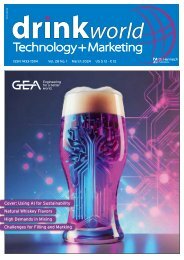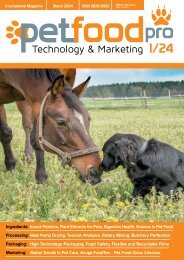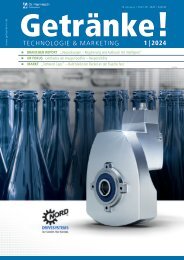petfood pro 4/2022
PetFood PRO is the international magazine for executives and specialists in the manufacture of food for domestic animals – the pet food industry. The magazine focuses on food and delicacies for dogs, cats and other small animals, ornamental birds and fish, as well as animals kept in terrariums. We publish feature articles, reports and announcements about new ingredients, technology, equipment and processes, packaging machinery and materials as well as marketing trends and developments. Readers are executives, product developers and specialists in the pet food industry, including process and packaging engineers. PetFood PRO will be published in English. Circulation is worldwide, with an emphasis on important growth markets.
PetFood PRO is the international magazine for executives and specialists in the manufacture of food for domestic animals – the pet food industry. The magazine focuses on food and delicacies for dogs, cats and other small animals, ornamental birds and fish, as well as animals kept in terrariums.
We publish feature articles, reports and announcements about new ingredients, technology, equipment and processes, packaging machinery and materials as well as marketing trends and developments. Readers are executives, product developers and specialists in the pet food industry, including process and packaging engineers. PetFood PRO will be published in English. Circulation is worldwide, with an emphasis on important growth markets.
You also want an ePaper? Increase the reach of your titles
YUMPU automatically turns print PDFs into web optimized ePapers that Google loves.
Only INGREDIENTS the best for<br />
our loved ones!<br />
Figure 4: Water activity and microbial growth. ⅺ<br />
used. It can cause two <strong>pro</strong>blems. Spoilage<br />
and decomposition of pet food, with<br />
consequential loss of organoleptic<br />
features and loss of nutrients, not only<br />
micro-nutrients, such as vitamins, but<br />
also macro-nutrients, such as <strong>pro</strong>teins<br />
and lipids. The decomposition <strong>pro</strong>cess<br />
leads to the formation of some noxious<br />
substances, such as biogenic amines.<br />
The second potential consequence of<br />
microbial spoilage is food poisoning,<br />
from the growth of pathogenic microbes,<br />
such as Salmonella spp., Listeria<br />
monocytogenes, various Bacillus species,<br />
and many other bacteria.<br />
Water activity plays a crucial role in<br />
the physical, chemical, and biological<br />
stability of foodstuff. It is the ratio<br />
between the vapor pressure of water in<br />
a certain material and the vapor pressure<br />
of pure water, at the same temperature.<br />
In simpler terms, it is an index referred<br />
to in food that is used to express the<br />
availability of water free from bonds<br />
with other components and which can<br />
be used for chemical and biological<br />
reactions. The index is expressed as an<br />
absolute number between zero and<br />
one: the higher the value, the higher<br />
the availability of water for microbial<br />
growth and therefore the easier that<br />
spoilage can occur. Water activity is not<br />
to be confused with moisture content.<br />
Moisture is the total amount of free and<br />
bound water. The relationship between<br />
moisture and water activity depends on<br />
the specific material: there are specific<br />
molecules and substances, that can<br />
absorb or bind water and lower water<br />
activity, even if the moisture level is not<br />
affected. A water activity index below 0.6<br />
is considered as safe because it allows<br />
no mould, yeast or bacterial growth, and<br />
enzymatic reactions are well restrained.<br />
So, water activity index defines if a food is<br />
perishable or stable. That is why it is used<br />
as key point of quality control <strong>pro</strong>grams.<br />
When we refer to dry pet foods, we are<br />
speaking of foods that are typically stable<br />
thanks to their <strong>pro</strong>duction <strong>pro</strong>cesses, that<br />
involves heat treatment, and potentially<br />
the use of water-binding substances. The<br />
challenge to the pet food industry is to<br />
find the right combination of ingredients,<br />
<strong>pro</strong>cessing, and packaging to create<br />
<strong>pro</strong>ducts that meet safety, quality, and<br />
cost parameters, and to satisfy consumers.<br />
Therefore, water activity could be used not<br />
only as a quality parameter, but also as an<br />
active development tool.<br />
It is possible to intervene against microbial<br />
development by lowering water activity<br />
as much as possible. In many cases, it<br />
is not possible to lower it below the<br />
safe value of 0.6, therefore it is essential<br />
to act in other ways, such as by using<br />
specific substances called preservatives.<br />
These kinds of additives intervene by<br />
altering the pH inside the microbial cell,<br />
interrupting its cellular functions to<br />
destroy the cell. Organic acids are widely<br />
used as preservatives. They are defined as<br />
weak acids, because they release only part<br />
of their hydrogen atoms when put in a<br />
solution and depending on the pH of that<br />
solution, forming a balance between the<br />
whole molecule and the ion forms (called<br />
dissociated forms). In fact, this <strong>pro</strong>cess is<br />
called dissociation. So, weak acids can be<br />
found in undissociated form or at various<br />
level of partial dissociation. Strong acids,<br />
on the contrary, release all hydrogen atoms<br />
and therefore are totally dissociated when<br />
in solution. The active form of the organic<br />
acid, that can penetrate the microbial cell,<br />
is the undissociated form. The lower the<br />
pH of the solution, the more undissociated<br />
the acid is, and therefore the more effective<br />
it will be. The pH at which organic acids are<br />
totally undissociated varies for each acid,<br />
but is relatively low which, is unlikely to be<br />
suitable for a pet food matrix. Therefore,<br />
generally, the reference used instead<br />
is the pKa which is the pH at which the<br />
Real brewers‘ yeast!<br />
Really effective!<br />
Leiber YeaFi ®<br />
| unique synergy of brewers‘ yeast<br />
and functional fibres<br />
CeFi ® <strong>pro</strong><br />
| best values in bioavailability<br />
Biolex ® MB40<br />
| prebiotic. gut health. MOS<br />
Leiber ® Beta-S<br />
| pure beta-glucans for strong<br />
immune defence<br />
Leiber NuTaste ®<br />
| Natural. Pure. Delicious.<br />
For further information<br />
just get in touch with us!<br />
Visit our new website:<br />
leibergmbh.de<br />
Issue 4 <strong>2022</strong><br />
11<br />
Leiber GmbH | Hafenstraße 24 | 49565 Bramsche<br />
Germany | info@leibergmbh.de


















